“What did I know about Chechnya before last week? For someone who grew up in the 1990s the very word Chechnya meant a string of grainy images on TV showing people in battered camouflage outfits, shooting at each other amid destruction and ruin. Fear, wahhabis, Shamil Basayev, terrorism, mountains: these were the words that used to spring to my mind when someone mentioned Chechnya.
It still has a reputation as a frightening place where people get kidnapped and entire villages are razed. When I told my friends I was leaving for Chechnya on assignment they asked me in jest if I would need an armored vehicle. Many of then were visibly worried. But then I spoke to a colleague who had worked there for more than 15 years. He said: “You won’t find a safer place in Russia, be smart and you’ll be okay”.
I flew to Grozny, with mixed expectations. When we got there and I stepped out of Grozny’s Severny Airport, I knew this wasn’t Russia. It was a totally different, parallel world, a cross between Singapore and the Middle East, with veiled women, men in camouflage, Islamic skull caps and long beards, and armed police on every street corner. There was a mosque outside the main airport terminal. A huge portrait of Chechnya’s strongman leader Ramzan Kadyrov was just across the street, and another, smaller portrait of Russian president Vladimir Putin close by. The streets were spotless, a rarity in Russia where many cities are full of potholes and crumbling buildings. I got into a taxi and plunged into Grozny.
Grozny was once described as the world’s most destroyed city. I remember photographs from the 1990s depicting unthinkable destruction and suffering. It has changed in a way I found astounding. The quiet streets are now lined with trees and marble facades, the skyscrapers of Grozny city, the center point of Kadyrov’s reconstruction efforts, soar into the sky.
Locals lower their voices when describing their hard-line leader. He controls every construction site in the city. Locals say that if he doesn’t like how a project is going he often orders it to be knocked down and built anew. When his motorcade glides through the city, complete with sirens and columns of security vehicles, people freeze and stare with awe. His relatives hold key positions in government. His father, a former president, was killed in a bomb blast in 2004. Both men’s portraits glare from giant billboards. “Ramzan, thank you for Grozny!’ says a red neon light sign opposite the city’s giant central mosque.
Locals kept asking me: did I like the city? What did I think about the food, about Kadyrov? Often I didnt know what to say. Despite its friendly facade, it’s a city tightly controlled by Russian security forces. Locals know that sensitive things should not be said on the telephone. Public criticism of the government is not allowed. Journalists working for foreign media organisations are often treated with suspicion. From time to time while walking down the street I’d notice a man with a neutral facial expression shadowing me. Our eyes would meet sometimes. I smiled once, and he smiled back”. – Maxim Shemetov
It still has a reputation as a frightening place where people get kidnapped and entire villages are razed. When I told my friends I was leaving for Chechnya on assignment they asked me in jest if I would need an armored vehicle. Many of then were visibly worried. But then I spoke to a colleague who had worked there for more than 15 years. He said: “You won’t find a safer place in Russia, be smart and you’ll be okay”.
I flew to Grozny, with mixed expectations. When we got there and I stepped out of Grozny’s Severny Airport, I knew this wasn’t Russia. It was a totally different, parallel world, a cross between Singapore and the Middle East, with veiled women, men in camouflage, Islamic skull caps and long beards, and armed police on every street corner. There was a mosque outside the main airport terminal. A huge portrait of Chechnya’s strongman leader Ramzan Kadyrov was just across the street, and another, smaller portrait of Russian president Vladimir Putin close by. The streets were spotless, a rarity in Russia where many cities are full of potholes and crumbling buildings. I got into a taxi and plunged into Grozny.
Grozny was once described as the world’s most destroyed city. I remember photographs from the 1990s depicting unthinkable destruction and suffering. It has changed in a way I found astounding. The quiet streets are now lined with trees and marble facades, the skyscrapers of Grozny city, the center point of Kadyrov’s reconstruction efforts, soar into the sky.
Locals lower their voices when describing their hard-line leader. He controls every construction site in the city. Locals say that if he doesn’t like how a project is going he often orders it to be knocked down and built anew. When his motorcade glides through the city, complete with sirens and columns of security vehicles, people freeze and stare with awe. His relatives hold key positions in government. His father, a former president, was killed in a bomb blast in 2004. Both men’s portraits glare from giant billboards. “Ramzan, thank you for Grozny!’ says a red neon light sign opposite the city’s giant central mosque.
Locals kept asking me: did I like the city? What did I think about the food, about Kadyrov? Often I didnt know what to say. Despite its friendly facade, it’s a city tightly controlled by Russian security forces. Locals know that sensitive things should not be said on the telephone. Public criticism of the government is not allowed. Journalists working for foreign media organisations are often treated with suspicion. From time to time while walking down the street I’d notice a man with a neutral facial expression shadowing me. Our eyes would meet sometimes. I smiled once, and he smiled back”. – Maxim Shemetov
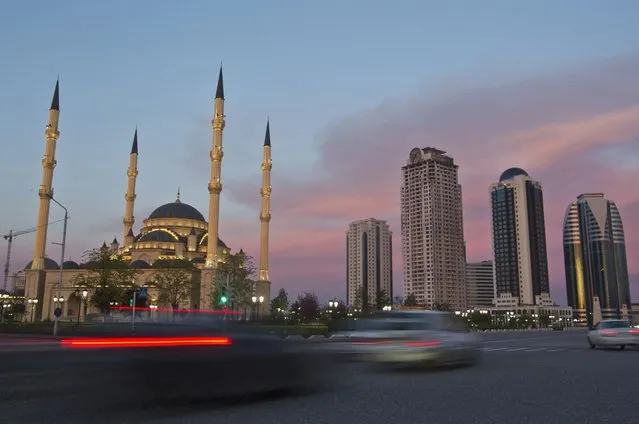
Cars drive along Akhmad Kadyrov Avenue, with the Heart of Chechnya mosque and skyscrapers in the background in the Chechen capital Grozny April 27, 2013. (Photo by Maxim Shemetov/Reuters)
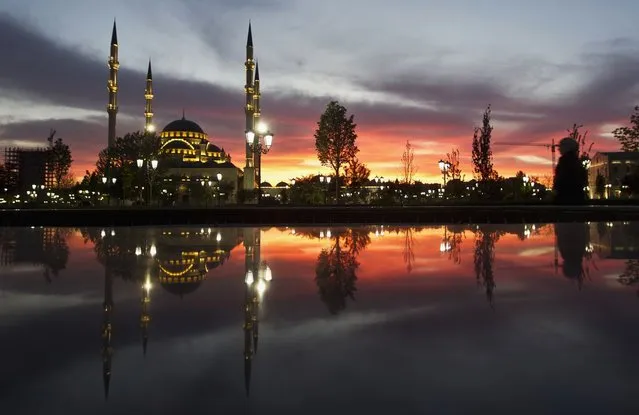
The Heart of Chechnya mosque is seen in the Chechen capital Grozny April 27, 2013. (Photo by Maxim Shemetov/Reuters)
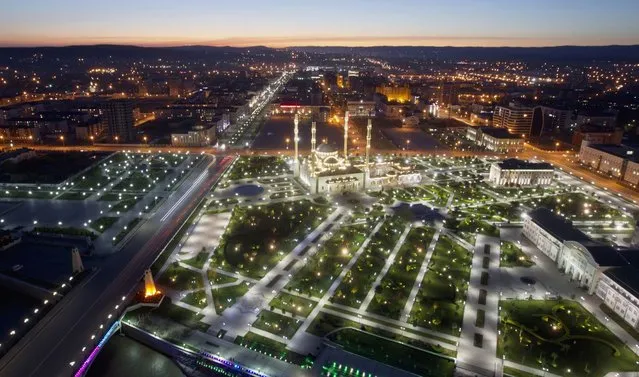
An aerial view shows the centre of the Chechen capital Grozny April 29, 2013. (Photo by Maxim Shemetov/Reuters)
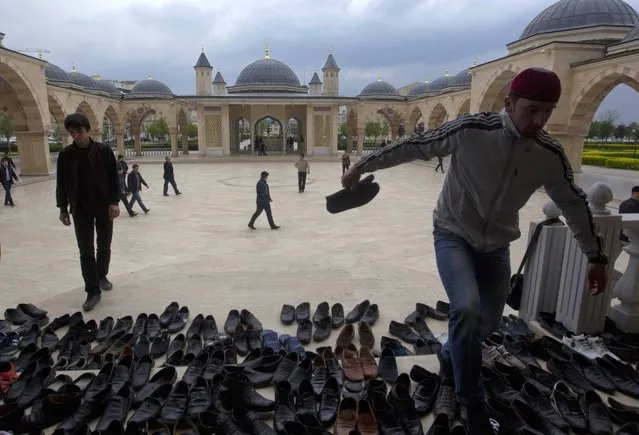
Muslim men arrive for Friday prayers at the central mosque in the Chechen capital Grozny April 26, 2013. (Photo by Maxim Shemetov/Reuters)
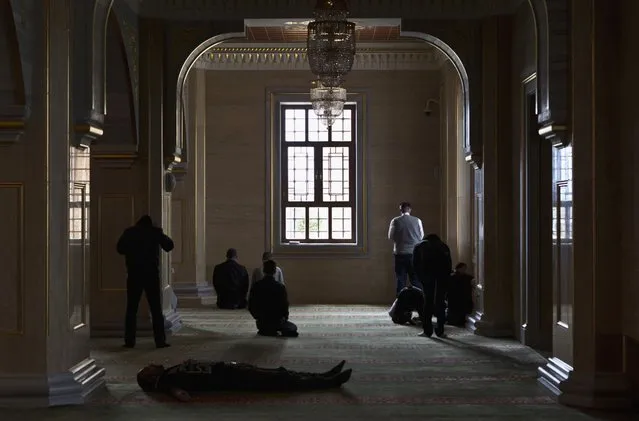
Muslim men wait for Friday prayers in the Heart of Chechnya Mosque in the Chechen capital Grozny April 26, 2013. (Photo by Maxim Shemetov/Reuters)
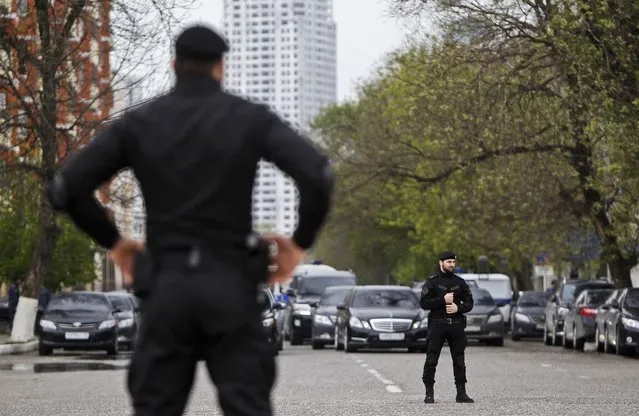
Special forces officers stand guard during a government-organised event marking Chechen language day in the centre of the Chechen capital Grozny April 25, 2013. (Photo by Maxim Shemetov/Reuters)
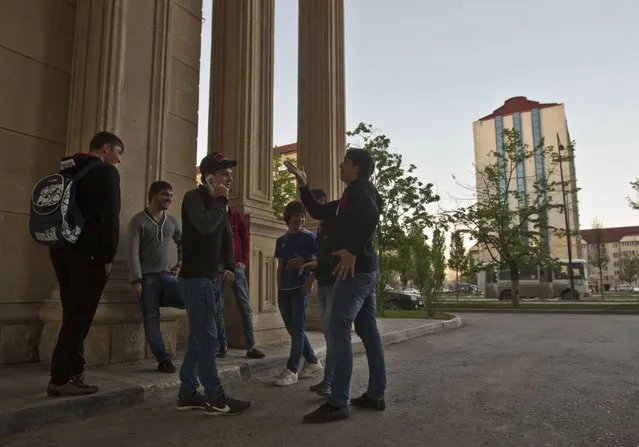
A group of young Chechen men hang out on a street corner in the centre of the Chechen capital Grozny April 29, 2013. (Photo by Maxim Shemetov/Reuters)
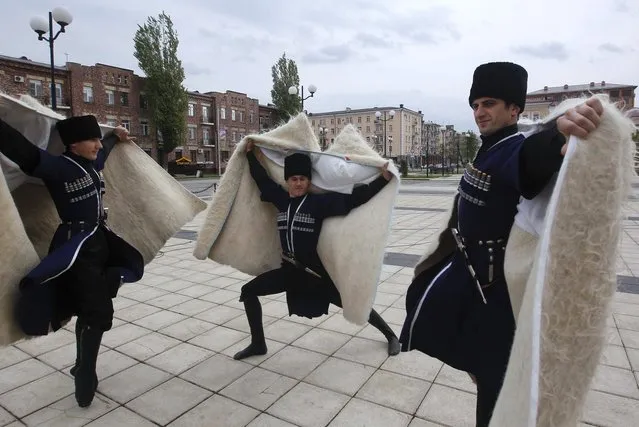
Members of a Chechen dance group pose for photographers at a government-organised event marking Chechen language day in the centre of the Chechen capital Grozny April 25, 2013. (Photo by Maxim Shemetov/Reuters)
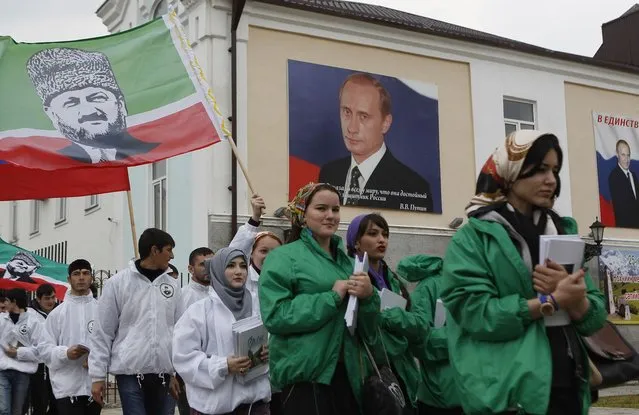
Members of a youth club supporting former Chechen leader Akhmad Kadyrov (printed on flag) march along a street during a rally in the centre of the Chechen capital Grozny April 25, 2013. (Photo by Maxim Shemetov/Reuters)
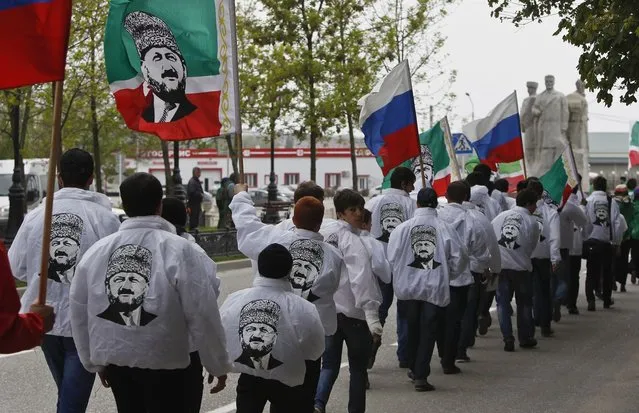
Members of a youth club supporting former Chechen leader Akhmad Kadyrov march along the street during a rally in the centre of the Chechen capital Grozny April 25, 2013. (Photo by Maxim Shemetov/Reuters)
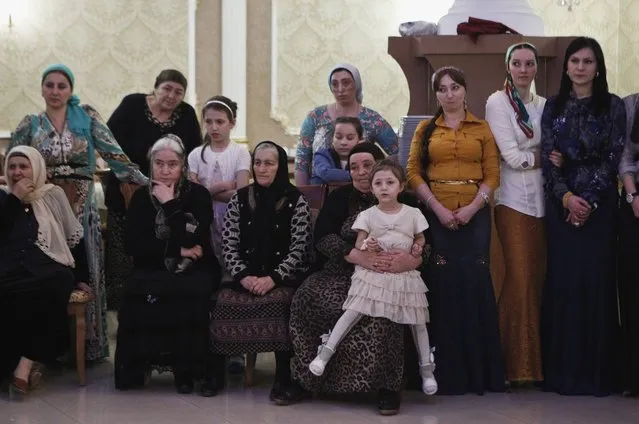
Women watch dancing at a wedding party in the Chechen capital Grozny April 24, 2013
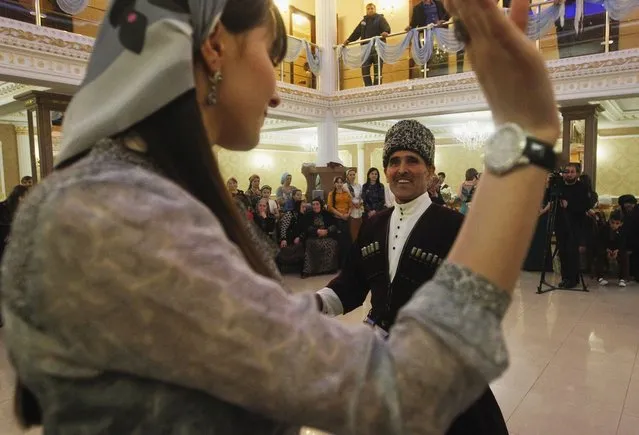
Guests dance at a wedding in the Chechen capital Grozny April 24, 2013. (Photo by Maxim Shemetov/Reuters)
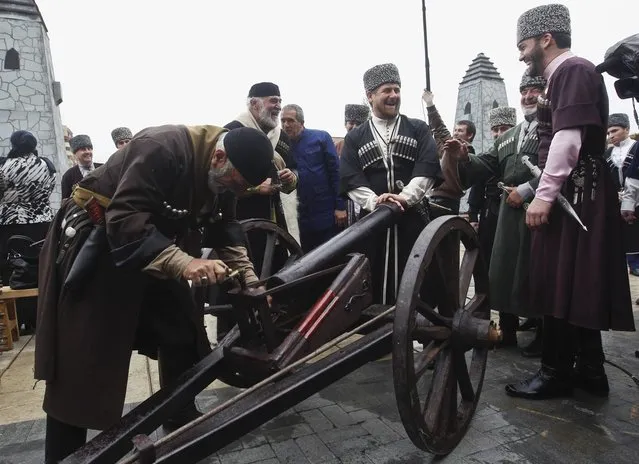
Chechen leader Ramzan Kadyrov (C) watches as men load up a cannon during a government-organised event marking Chechen language day in the centre of the Chechen capital Grozny April 25, 2013. (Photo by Maxim Shemetov/Reuters)
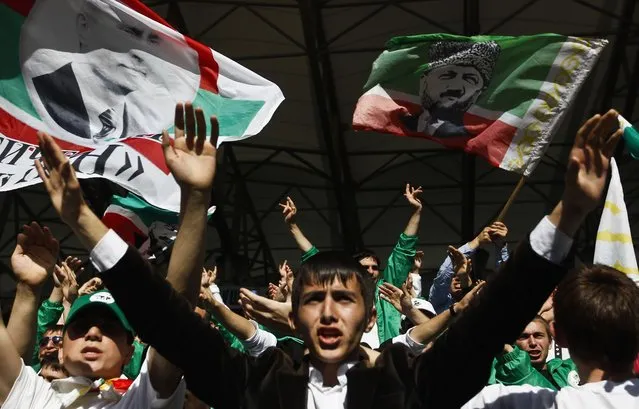
Terek Grozny fans support their team during a soccer match against Amkar Perm at the Akhmad Arena stadium in the Chechen capital Grozny April 27, 2013. (Photo by Maxim Shemetov/Reuters)
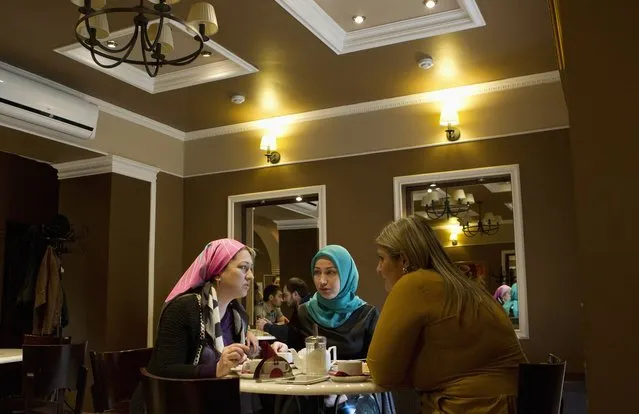
Chechen women chat in a cafe in the centre of the Chechen capital Grozny April 23, 2013. (Photo by Maxim Shemetov/Reuters)
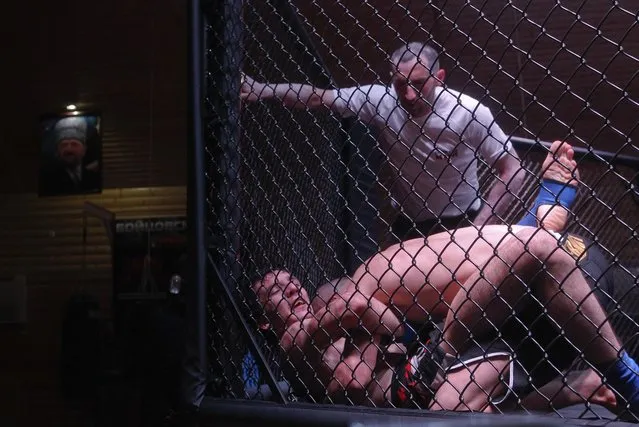
Participants in a local mixfight competition wrestle in the ring, with a portrait of former Chechen leader Akhmad Kadyrov in the background in the village of Goryachevodsk, Russia April 24, 2013. (Photo by Maxim Shemetov/Reuters)
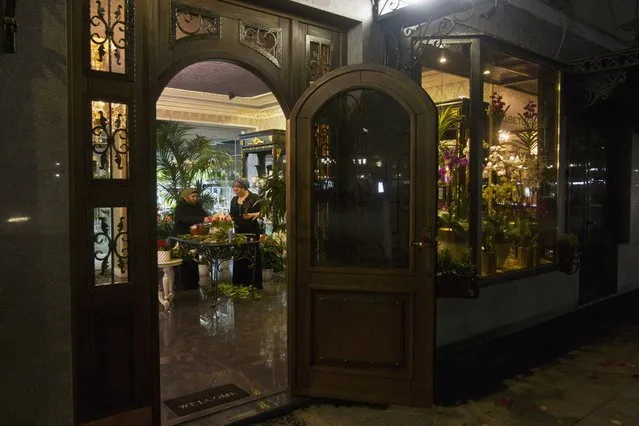
Florists arrange flowers in the Chechen capital Grozny April 22, 2013. (Photo by Maxim Shemetov/Reuters)
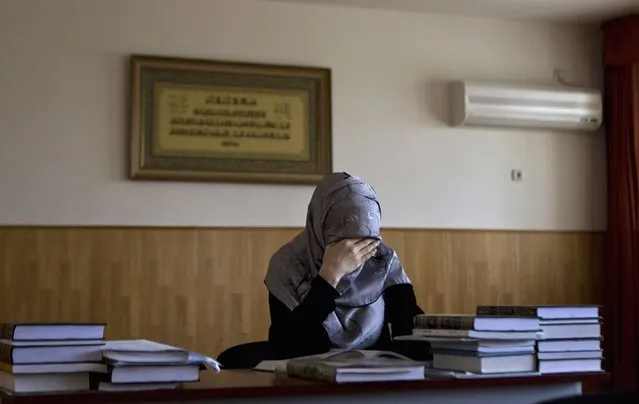
A student attends a lesson in Sharia law at the Russian Islamic University in the Chechen capital Grozny April 23, 2013. (Photo by Maxim Shemetov/Reuters)
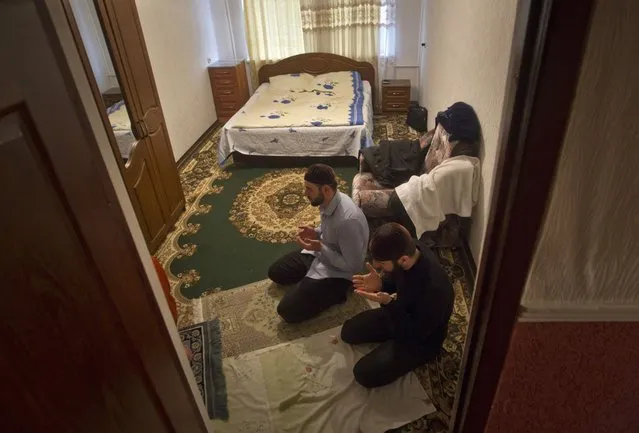
Anzor and Salakhutdin, students at the Russian Islamic University, pray in their flat in the Chechen capital Grozny April 23, 2013. (Photo by Maxim Shemetov/Reuters)
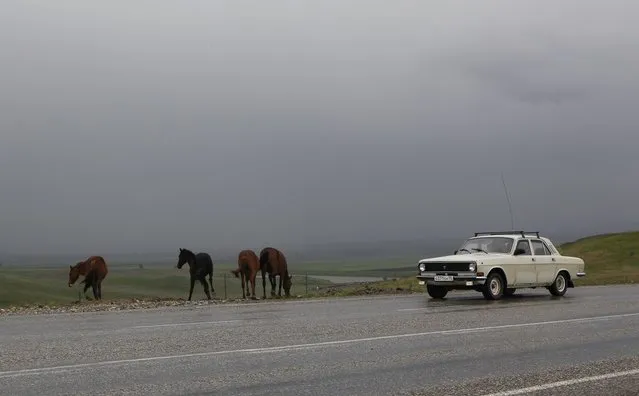
A car drives past horses, standing at the edge of a road, outside the Chechen capital Grozny April 24, 2013. (Photo by Maxim Shemetov/Reuters)
14 May 2013 12:02:00,
post received
0 comments
